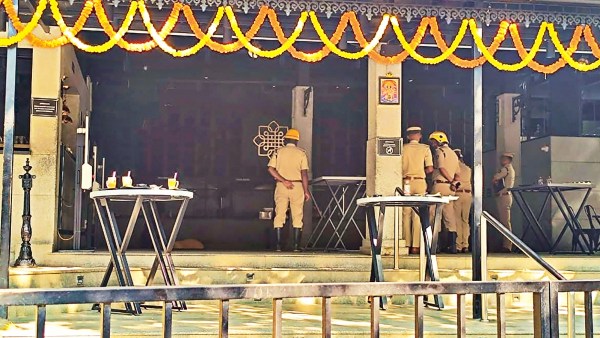Bengaluru restaurant blast: Man wearing cap, mask a suspect; IED like one used in Mangaluru, 2022
The suspect entered the restaurant and had a snack before leaving. A tiffin box bag kept inside a larger bag that was left near the hand-wash area of the restaurant contained the IED that caused the blast, the police sources said.
 (L-R) The key suspect is seen in a CCTV footage; screengrab from another survelliance camera footage of the blast moment. (File Photos)
(L-R) The key suspect is seen in a CCTV footage; screengrab from another survelliance camera footage of the blast moment. (File Photos)A MAN wearing a cap, glasses and a mask, captured by CCTV cameras at Rameshwaram Cafe around an hour before a blast occurred at 12.56 pm on Friday, has emerged as a key suspect. Police sources said efforts were being made to identify the man, who had partially concealed his face.
The suspect entered the restaurant and had a snack before leaving. A tiffin box bag kept inside a larger bag that was left near the hand-wash area of the restaurant contained the IED that caused the blast, the police sources said.
Nine persons suffered injuries in the blast which was marked by a loud sound, fire and smoke but was restricted to the area where the bag was placed. A 45-year-old woman suffered nearly 40 per cent injuries and is in ICU while others suffered minor injuries and shock.
#RameshwaramCafe blast: Here’s the CCTV footage of
the man wearing a cap, glasses and a mask, who has emerged as a key suspect. pic.twitter.com/xQIB1HNCZd— The Indian Express (@IndianExpress) March 2, 2024
Preliminary investigations have indicated an IED with a bulb filament that was heated to act as a detonator – after being triggered by a digital timer — in a low-intensity device contained in a steel tiffin box.
#Karnataka #BengaluruBlast #RameshwaramCafe #RameshwaramCafeBlast #Bengaluru
A total of nine persons were injured in the incident but one woman sustained serious injuries. The police are now looking for the man who left behind the bag in the restaurant. pic.twitter.com/Qq0A0Jeo92
— Express Bengaluru (@IEBengaluru) March 1, 2024
The explosive material used is yet to be identified but sources indicated it was a low-intensity blast involving a combination of easily available explosive material contained in a box which disintegrated.
The filament detonator has been typically used by self-taught Islamic State (IS) operatives, and was seen in a device that accidentally exploded in an auto-rickshaw in Mangaluru on November 19, 2022.
Police sources said that there are many similarities between the device used at the Rameshwaram Cafe and devices linked to the IS module involved in the Mangaluru explosion.
The Mangaluru incident, in which a self-taught alleged IS activist Mohammed Shariq was arrested after he sustained burn injuries, is currently being investigated by the NIA.
“The detonator is the same as the one in the Mangaluru incident but some other aspects like the explosives used seem to be a bit different,” a police source said.
The Bengaluru city police in a press statement said the HAL jurisdiction police have registered a case under sections of the Unlawful Activities (Prevention) Act of 1967 and Explosives Substances Act, suggesting that the blast is being treated as a terrorist incident.
NIA officers were at the scene of the incident through Friday and the agency is likely to take over the probe of the case.
On November 19, 2022, Mohammed Shariq, 24, suffered 40 per cent burn injuries after an almost similar IED he created went off accidentally in a bag he was carrying on his lap in an auto-rickshaw in Mangaluru. He was arrested after the blast.
The main explosive material used in that IED was identified as around 500 gm of gunpowder, which has potassium nitrate as its main chemical, and is fairly easily available for purchase.
 Firemen and other officials at the Rameshwaram Cafe after a fire caused by a suspected cylinder explosion, in Bengaluru, Friday, March 1, 2024. At least five persons sustained injuries in the incident. (PTI Photo)
Firemen and other officials at the Rameshwaram Cafe after a fire caused by a suspected cylinder explosion, in Bengaluru, Friday, March 1, 2024. At least five persons sustained injuries in the incident. (PTI Photo)
The low-intensity device was suspected to have been built by referring to literature on making IEDs using easily available materials by “inexperienced persons”, police sources had said at the time.
While potassium nitrate or gunpowder was the main explosive in the pressure cooker device in November 2022, the filaments of two 12-watt electric bulbs were the detonators which were connected to a printed circuit board timer and three nine-volt batteries, the police investigations had found.
The blast of the IED contained in a pressure cooker was to be triggered by the heating of the bulb filaments that were kept in contact with the gunpowder.
The triggering of the device occurred prematurely resulting in the explosion in the auto-rickshaw while the IED was being transported.
When the incident occurred, Shariq was wanted in a terror case registered in Shivamogga in September that year for alleged links to the IS. Earlier in 2020, he was arrested for painting anti-national graffiti on a wall in Mangaluru, police sources said.
Two associates of Shariq – Maaz Ahmed and Syed Yasin, both engineers – were arrested by Shivamogga police in September 2022 in a terror case while Shariq was reported as absconding.
Police had said at the time that the accused learned the concept of making bombs from videos.
Most of the suspected members of the Shivamogga-Mangaluru IS module involved in the 2022 incidents were arrested while a key financier, Arafath Ali, was deported from the UAE last year.







